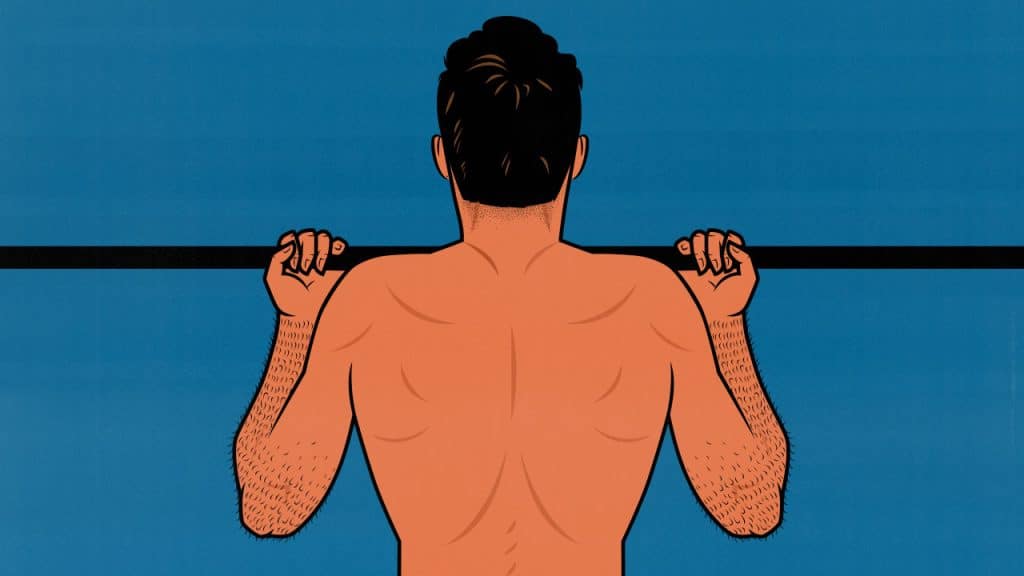
Calisthenics Vs Weights: Which Builds More Muscle?
Both calisthenics and weight training can stimulate muscle growth. That’s not answering your question, though. Resistance bands, bodybuilding, and powerlifting all stimulate muscle growth. So can cardio. So can flexing your muscles (study).
We’ve helped thousands of people bulk up over the past decade, some using weights, others with pure calisthenics. We’ve seen how their results compare. There’s also research comparing the results people get with calisthenics vs weight training. We can take that into consideration, too.
We don’t have a bias. We don’t sell weights or gymnastic rings. Our brand isn’t built on one approach or the other. We’ve trained both ways. We’re happy to use and recommend whatever gives the best results.

The Basics of Calisthenics
Calisthenics uses bodyweight exercises to gain muscle and strength. The idea is to master your body weight using whatever equipment you have. It’s a scrappy approach to building muscle. It works quite well.
The best calisthenics exercises for building muscle are:
- Push-ups and dips for your chest, shoulders, triceps, and core.
- Chin-ups and pull-ups for your upper back, lats, biceps, and core.
- Crunches, V-sits, L-sits, and leg raises for your abs.
- Split squats, lunges, and pistol squats for your lower body.
Some of the exercises can be done with just your body weight. Others require equipment, such as a pull-up bar, dip bar, gymnastic rings, and parallettes.
You start with easy variations of the exercises, focusing on adding reps every time you repeat a workout. When you get strong enough, you progress to harder variations.
For example, you could start by doing push-ups with your hands raised on a bench. When you can do 20 reps in a row with good technique, switch to doing push-ups from the floor. When you can do 20 of those, raise your feet up on a bench.

The Basics of Weight Training
Weight training uses barbells, dumbbells, exercise machines, and cables to stimulate muscle growth. As you grow gradually stronger, you add weight to the exercises. It’s a simple and methodical way of building muscle.
The best weight training exercises for building muscle are:
- Deadlifts for your hamstrings, hips, and entire back.
- Squats for your quads, hips, and spinal erectors.
- Presses for your chest, shoulders, and triceps.
- Rows for your upper back, lats, and spinal erectors.
- Biceps curls, triceps extensions, and lateral raises for your arms.
You can do all of these exercises with dumbbells or a barbell. Many people use exercise machines and cables, too. Sometimes those machines offer small advantages over the dumbbell or barbell variations.
Because you have control over how much weight you’re lifting, you have more control over the exercise variations you choose and the repetition range you lift in. This makes weight training simpler, less painful, more customizable, and more flexible. However, that doesn’t tell us whether it’s better at stimulating muscle growth.

Which Produces Better Results?
Both weight training and calisthenics have their own style and methods. Calisthenics is a quest for bodyweight mastery, whereas weight training is a methodical way of progressively overloading your muscles. Which builds more muscle?
The most recent study is by Ogawa and colleagues (study). One group of participants followed a weight training workout program, and the other followed a bodyweight workout program. Both groups gained a similar amount of muscle size, with no statistically significant differences between the two:

It’s tempting to say the weight training group built more muscle. That probably isn’t the right interpretation. First, the results didn’t reach statistical significance. Second, the bodyweight group lost some fat in their muscles, making their muscles a little smaller. Overall, I think these results are comparable, especially when we consider earlier research.
In an earlier study by Kikuchi and colleagues, the researchers had one group do push-ups and the other do bench presses (study). After 8 weeks, both groups gained a large amount of muscle in their chests and a moderate amount of muscle in the triceps. There were no significant differences in results between the calisthenics workouts and the weight training workouts.
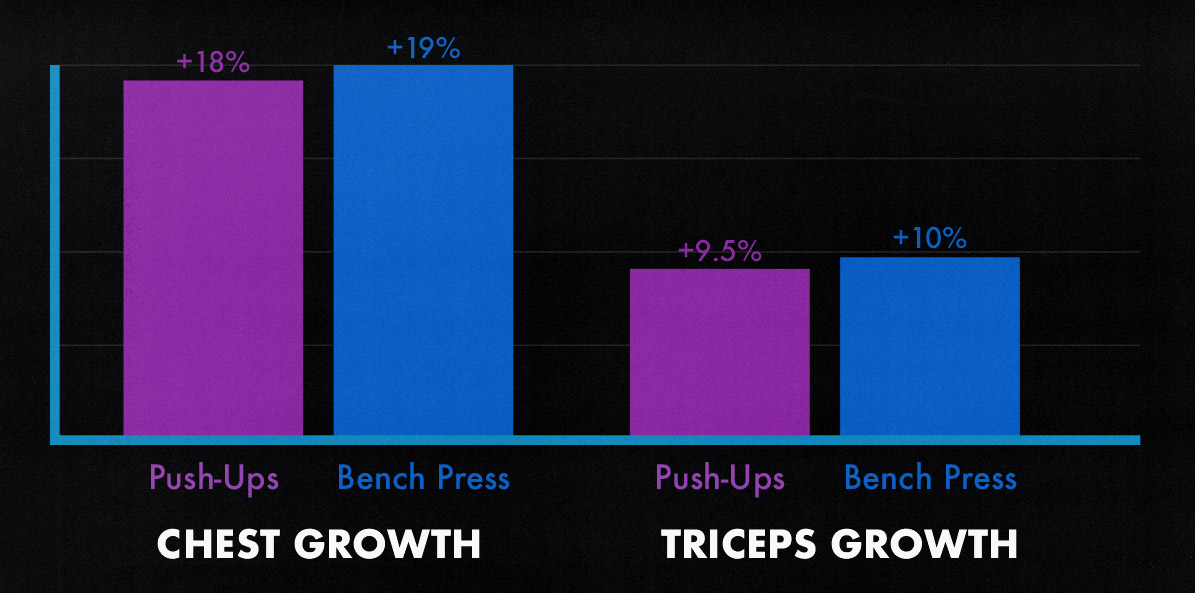
In fact, you could make a strong argument for the push-up being the better exercise. After all, they do a better job of training your abs and serratus muscles.
- Your serratus muscles are the big muscles underneath your armpits. During the bench press, your shoulder blades are locked in place. With push-ups, your shoulder blades are free to move. This is great for your shoulders, great for your posture, and great for building muscle.
- Your abs are trained by push-ups when you hold your torso in a sturdy “plank” position. Again, this is great for your posture, and it’s great for building muscle.
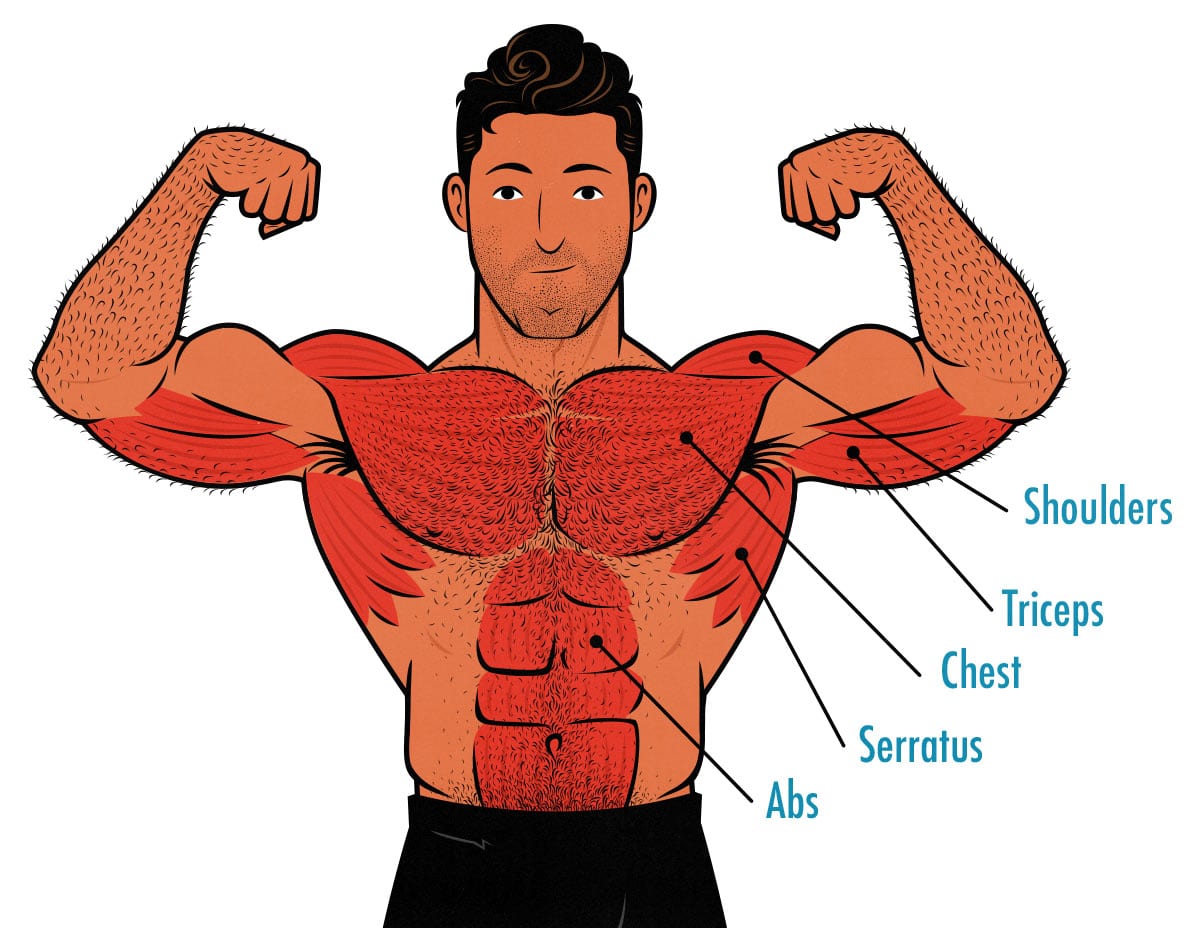
The same is true when comparing chin-ups against lat pulldowns. They both train our back muscles similarly hard, but chin-ups do a much better job of engaging our abs, resulting in more muscle growth overall.
On that note, crunches, knee raises, and leg raises are fantastic for building bigger abs. Then, as you get stronger, you can progress to more advanced variations, such as L-sit pull-ups. You don’t need weights to build a fearsome 6-pack.
With other exercises, the advantage goes the other way. There aren’t any calisthenics exercises that stimulate as much muscle growth in your lower body as squats. No bodyweight exercise comes close to rivalling the muscle growth you can stimulate with deadlifts.
In an ideal world, you’d have access to both your body and weights, allowing you to do push-ups, chin-ups, squats, and deadlifts, along with a slew of other exercises.
Which Approach is Easier?
One potential issue with calisthenics is that it can be difficult to make bodyweight exercises heavier. If you were lifting weights, you could add a few pounds to your exercises every week, ensuring gradual progressive overload. It’s simple and easy.
With calisthenics, progressive overload gets harder. You can add more reps to your sets, which can be painful. Or you could switch to more advanced variations, which can be complicated. For example, when you switch from raised push-ups to regular push-ups, you’re training your chest at a different angle, stimulating different muscle fibres.
For another example, in a study by Schoenfeld and colleagues, the participants doing high-rep sets (30–40 reps per set) complained of intense pain and would often throw up during the workouts (study). It’s a brutal way to train. If you can only do 10 push-ups and 3 chin-ups, this won’t be an issue for you yet, but it might cause problems one day.
You can solve this issue quite easily by buying a weighted vest, but at that point, it might make more sense to buy a pair of adjustable dumbbells instead.
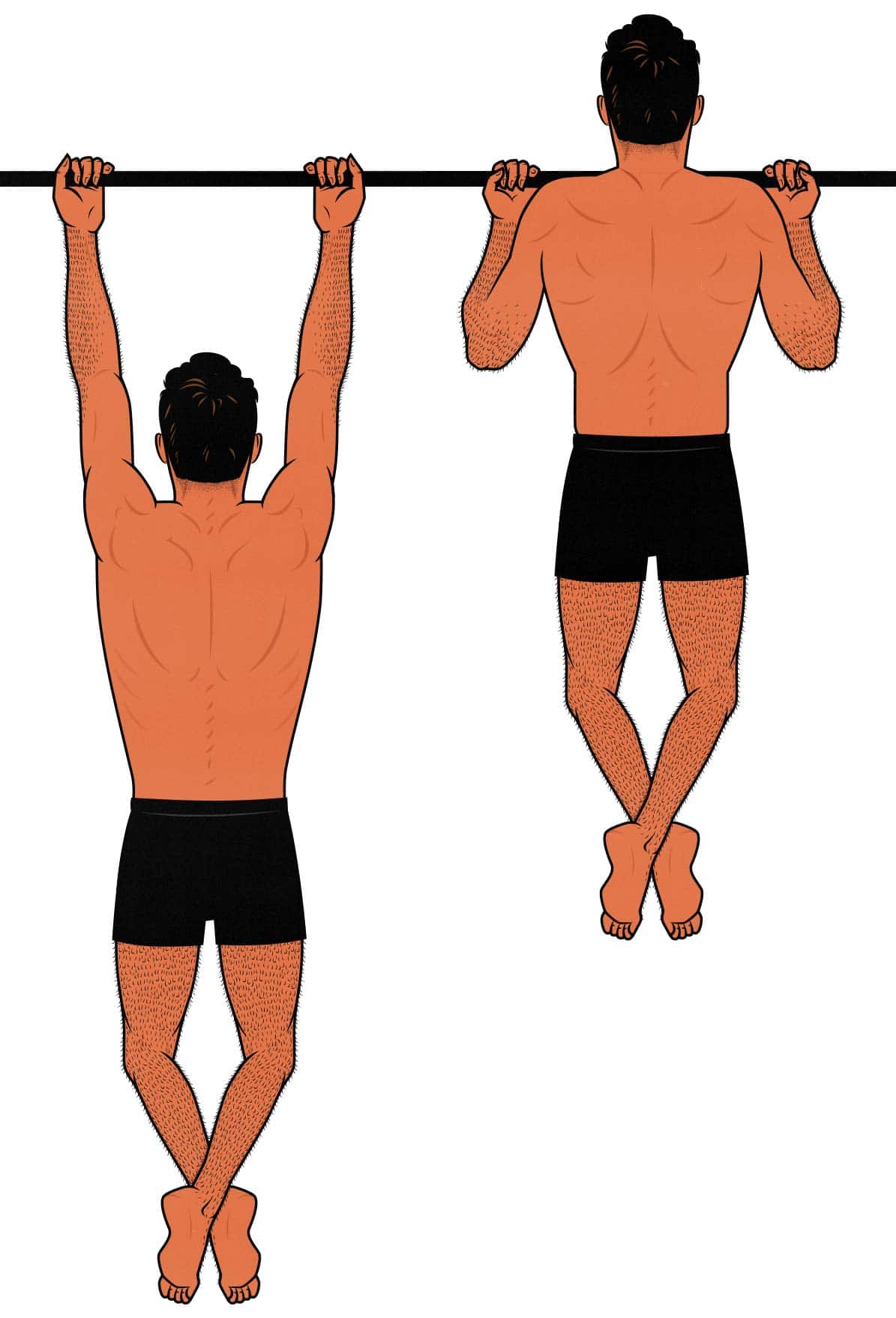
Calisthenics Athletes Vs Bodybuilders
The best calisthenics athletes build their training routines around bodyweight exercises. That’s the foundation. From there, they add in whatever exercises help them get bigger, stronger, and better at their passion. Almost always, that means adding weights to their workout programs.
The best bodybuilders build their workout programs around big compound exercises. That includes squats and deadlifts. It also includes bodyweight exercises like push-ups, chin-ups, and dips. They want the best results, so they combine both methods together.
Should You Get Weights?
You can start working out right now with whatever you have. If all you have is your body, you can do 3–4 sets of push-ups one day, then go on a 30-minute walk the next. Keep alternating between those two simple workouts, always trying to get more push-ups and more steps than last time. If you wait until your circumstances are perfect, you’ll miss out on the benefits you can get today, and you may find yourself waiting forever.
When you’re ready to take things to the next level, you can buy some wooden gymnastic rings to improve your calisthenics training. You can also buy some adjustable dumbbells so that you can begin weight training. That way, you can do goblet squats, dumbbell Romanian deadlifts, overhead presses, biceps curls, triceps extensions, and lateral raises. That will round out your routine, allowing you to build more muscle more easily.
IronMaster and BowFlex are the Ferraris of adjustable dumbbells, but cheaper ones work nearly as well. The main difference is in convenience, not results. Or you could join a gym. Or build a barbell home gym.
The Results of A Combined Approach
We’ve been helping people bulk up for over a decade now. The people using a mix of both calisthenics and weights get the best results. Sometimes, that means training with a pull-up bar and adjustable dumbbells at home. Other times, that means training at a full gym. That’s entirely up to you.
Here are the results one of our members got by combining calisthenics and weight training:
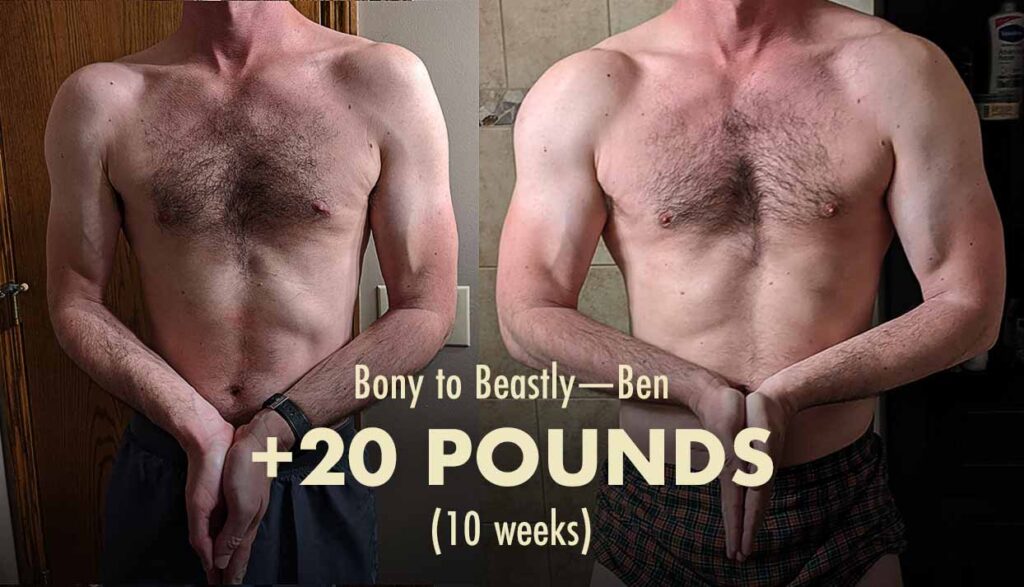
Personally, I have a barbell home gym with a dip bar, a pull-up bar, and some gymnastic rings, allowing me to do all the best weight training and calisthenics exercises. Mind you, it took me ten years of training to accumulate all of this equipment. You can start with whatever you have.
Here are my personal bulking results, going from 130 to 200 pounds at 6’2:

Conclusion
Calisthenics are great for building muscle. Push-ups and chin-ups, in particular. They’re two of the best muscle-building exercises, easily outperforming bench presses and lat pulldowns.
For your other muscle groups, weight training is better. Squats and deadlifts are the two best exercises for stimulating overall muscle growth. Biceps curls, triceps extensions, and lateral raises are the best exercises for bulking up your arms.
In an ideal world, combine both calisthenics and weight training, getting the best of both. In this world, use whatever you have. Add to it when you can.
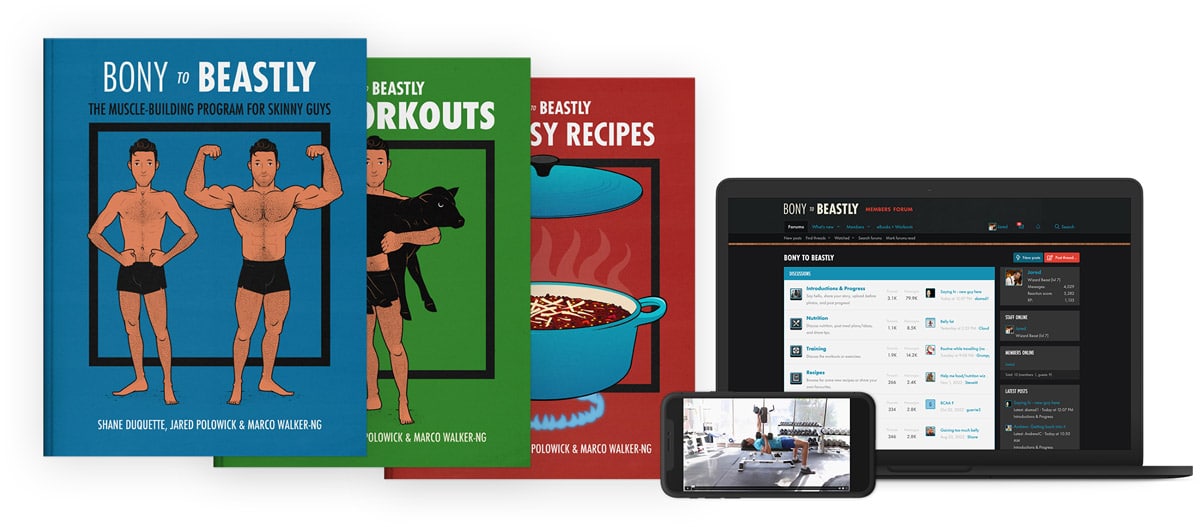
Alright, that’s it for now. If you want to know the ins and outs of building muscle, we have a free newsletter. If you want a full muscle-building program, including a 5-month workout routine, a bulking diet guide, a gain-easy recipe book, and online coaching, check out our Bony to Beastly Bulking Program. It combines both weight training and calisthenics, but we’ll help you build muscle with whatever you have.

